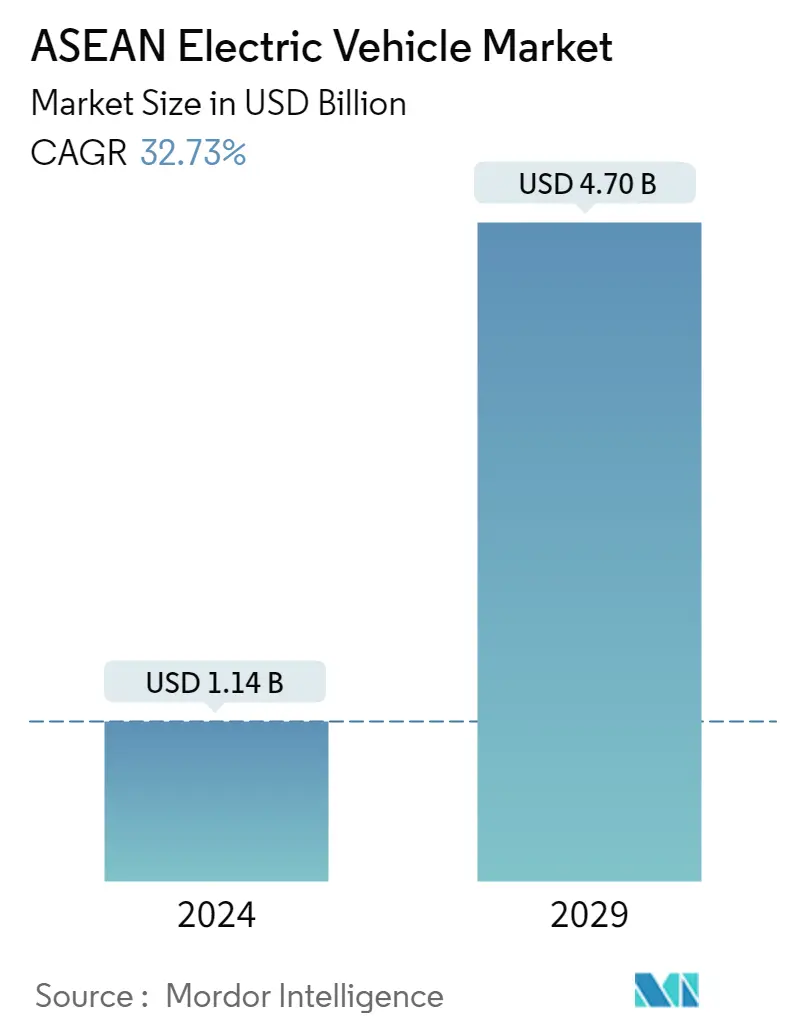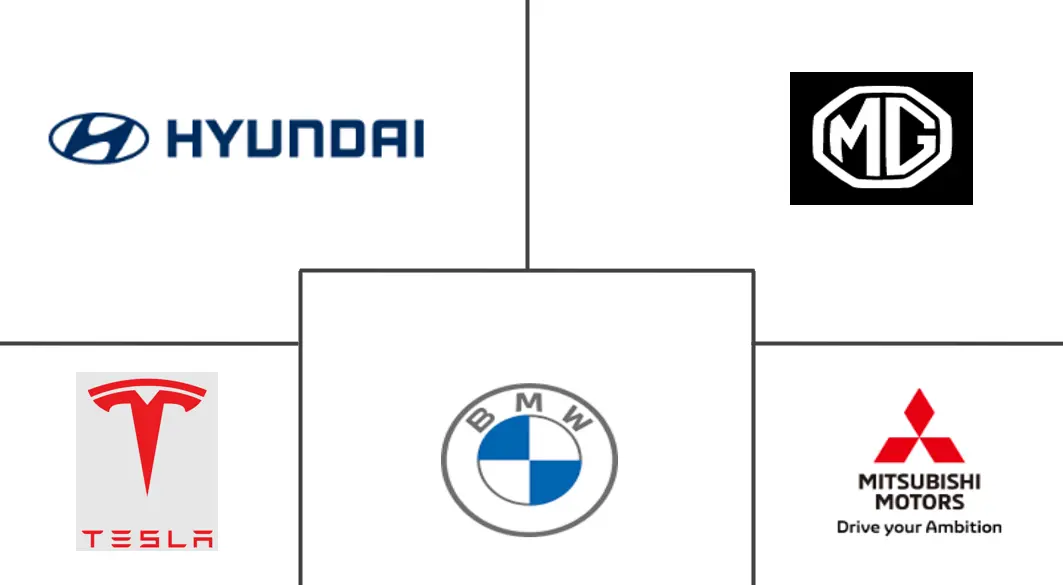Market Size of ASEAN Electric Vehicle Industry

| Study Period | 2019 - 2029 |
| Base Year For Estimation | 2023 |
| Market Size (2024) | USD 1.14 Billion |
| Market Size (2029) | USD 4.70 Billion |
| CAGR (2024 - 2029) | 32.73 % |
| Market Concentration | Medium |
Major Players
*Disclaimer: Major Players sorted in no particular order |
ASEAN EV Market Analysis
The ASEAN Electric Vehicle Market size is estimated at USD 1.14 billion in 2024, and is expected to reach USD 4.70 billion by 2029, growing at a CAGR of 32.73% during the forecast period (2024-2029).
As a result of the COVID-19 pandemic, manufacturing activities ceased for several months in the first half of 2020. Also, the disrupted supply chain and the shortage of chips in 2021 hurt the growth of the market studied. However, the automotive industry is now recovering from the losses and paving the way to introduce quality products to cater to the rising demand from consumers across the country. The automotive industry witnessed significant growth in terms of production in 2021, which is likely to increase the demand for electric vehicles across the country.
Government policies to support the growth of electric vehicles and plans to enlarge the electric vehicle charging infrastructure are expected to remain prominent market drivers during the forecast period. Several governments across the ASEAN region have announced plans to have a certain portion of their new vehicle sales electrified in the coming few years.
Governments play a vital role in encouraging the expansion of electric vehicle charging infrastructure. As ASEAN governments push for further vehicle electrification, there must be usage and purchase incentives that either lower the overall cost of ownership or make driving electric vehicles more convenient for customers. Although only a few incentives for purchasing electric vehicles or charging infrastructure are present in the Philippines, the country holds 5% and 4% of worldwide nickel and cobalt reserves, respectively, and has enormous potential to participate more actively in the EV battery production value chain.
EVs are becoming more popular in Indonesia, owing to ride-hailing companies like Grab, which announced a cooperation with the local power supplier PLN to expand its fleet charging infrastructure. In the coming years, public transportation operators such as Transjakarta want to increase their electric bus fleet to 10,000 units. Such instances are signs of the growth of the electric vehicle market across the region.
ASEAN EV Industry Segmentation
An electric vehicle is powered by an electric motor instead of an internal combustion engine. An electric vehicle uses a large traction battery pack to power the electric motor and must be plugged into charging equipment. Electric vehicles use batteries such as lead acid, nickel metal hydride, and lithium-ion batteries. Lithium-ion batteries are commonly found in electric vehicles due to their excellent energy retention.
The ASEAN electric vehicle market is segmented by vehicle type, drive train technology type, and country. Based on vehicle type, the market is segmented into passenger and commercial vehicles. Based on drive train technology, the market is segmented into a battery, plug-in hybrid, and fuel-cell electric vehicles. Based on the country, the market is segmented into Thailand, Malaysia, Indonesia, Singapore, and the Rest of ASEAN. For each segment, market size and forecast have been calculated based on value (USD million).
| By Vehicle Type | |
| Passenger Vehicle | |
| Commercial Vehicle |
| By Drive Train Technology Type | |
| Battery Electric Vehicle | |
| Plug-in Hybrid Electric Vehicle | |
| Fuel Cell Electric Vehicle |
| By Country | |
| Thailand | |
| Malaysia | |
| Indonesia | |
| Singapore | |
| Rest of ASEAN |
ASEAN Electric Vehicle Market Size Summary
The ASEAN electric vehicle market is poised for significant expansion, driven by a combination of government initiatives, consumer demand, and strategic investments by key players. The region's automotive industry is recovering from pandemic-induced disruptions, with a renewed focus on electric vehicles (EVs) as a response to increasing demand for sustainable transportation solutions. Governments across ASEAN are implementing policies to support EV adoption, including incentives for electrification and the expansion of charging infrastructure. These efforts are complemented by the region's rich reserves of essential minerals like nickel and cobalt, particularly in the Philippines, which position ASEAN as a potential hub for EV battery production. The growing popularity of EVs is further bolstered by collaborations between ride-hailing companies and local power suppliers, as seen in Indonesia, where companies like Grab are enhancing fleet charging capabilities.
Singapore stands out as a leader in EV infrastructure development, with ambitious plans to significantly increase the number of public charging points and promote EV adoption through financial incentives. The country's strategic focus on research and development has attracted investments from multinational corporations, fostering a robust local EV ecosystem. Meanwhile, major automotive players such as Hyundai, Tesla, and Mitsubishi are actively expanding their presence in the region, with new manufacturing plants and strategic partnerships aimed at bolstering local production capabilities. These developments, alongside supportive government policies and increasing consumer interest in fuel-efficient and technologically advanced vehicles, are expected to drive the ASEAN electric vehicle market's growth in the coming years.
ASEAN Electric Vehicle Market Size - Table of Contents
-
1. MARKET DYNAMICS
-
1.1 Market Drivers
-
1.2 Market Restraints
-
1.3 Industry Attractiveness - Porter's Five Forces Analysis
-
1.3.1 Threat of New Entrants
-
1.3.2 Bargaining Power of Buyers/Consumers
-
1.3.3 Bargaining Power of Suppliers
-
1.3.4 Threat of Substitute Products
-
1.3.5 Intensity of Competitive Rivalry
-
-
-
2. MARKET SEGMENTATION (Market Size by Value - USD Million)
-
2.1 By Vehicle Type
-
2.1.1 Passenger Vehicle
-
2.1.2 Commercial Vehicle
-
-
2.2 By Drive Train Technology Type
-
2.2.1 Battery Electric Vehicle
-
2.2.2 Plug-in Hybrid Electric Vehicle
-
2.2.3 Fuel Cell Electric Vehicle
-
-
2.3 By Country
-
2.3.1 Thailand
-
2.3.2 Malaysia
-
2.3.3 Indonesia
-
2.3.4 Singapore
-
2.3.5 Rest of ASEAN
-
-
ASEAN Electric Vehicle Market Size FAQs
How big is the ASEAN Electric Vehicle Market?
The ASEAN Electric Vehicle Market size is expected to reach USD 1.14 billion in 2024 and grow at a CAGR of 32.73% to reach USD 4.70 billion by 2029.
What is the current ASEAN Electric Vehicle Market size?
In 2024, the ASEAN Electric Vehicle Market size is expected to reach USD 1.14 billion.

